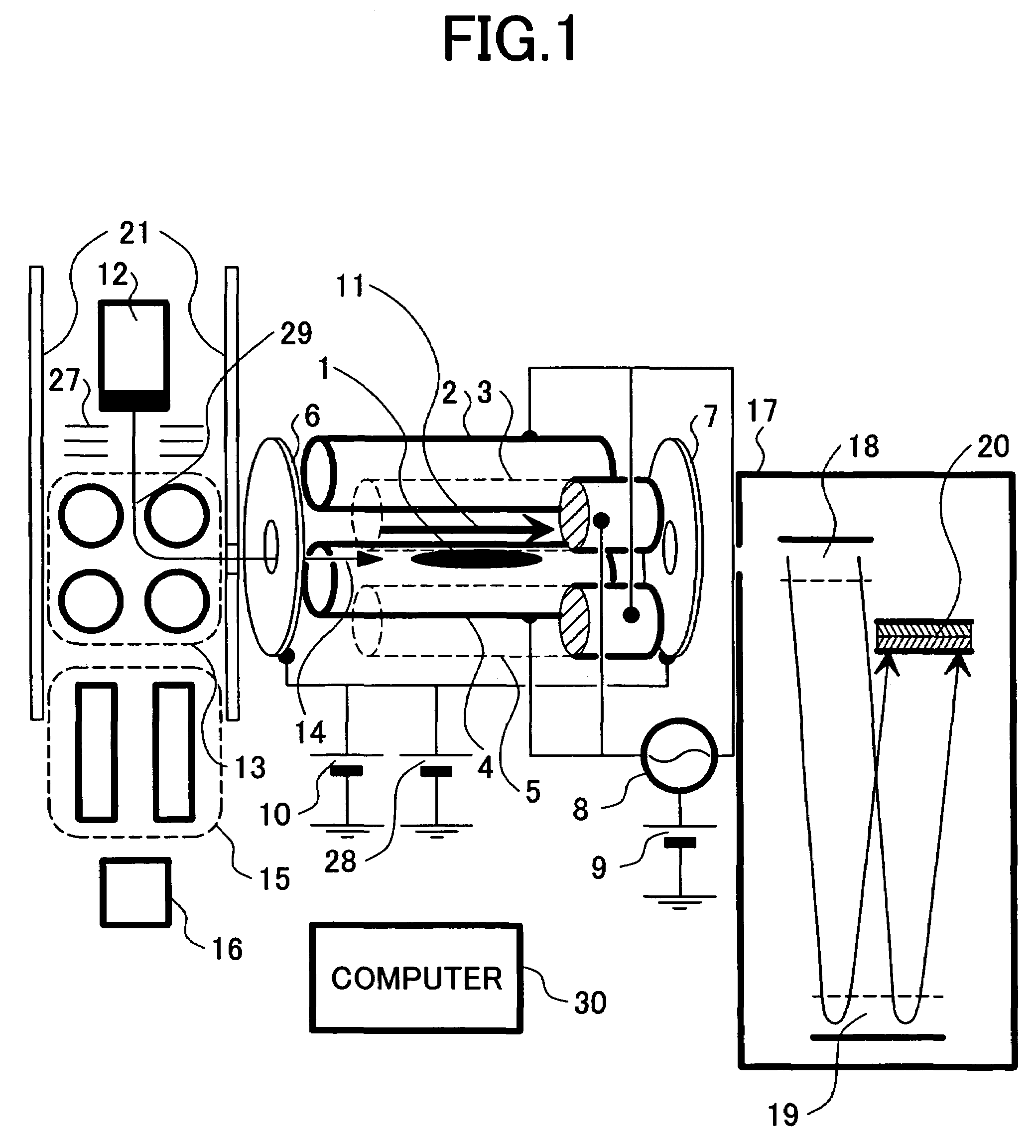Mass spectrometer
a mass spectrometer and biopolymer technology, applied in the field of sequence structure analysis of biopolymer using mass spectrometry, can solve the problems of loss of ions, difficulty in controlling reaction time, and less than 100% passing efficiency of ions through the penning trap, so as to reduce the heating effect of electrons, reduce radio frequency amplitude, and reduce the effect of heating electrons
- Summary
- Abstract
- Description
- Claims
- Application Information
AI Technical Summary
Benefits of technology
Problems solved by technology
Method used
Image
Examples
example 1
[0062]FIG. 1 shows a first example of the present invention. A mass spectrometer capable of carrying out ECD of this example is composed of a reaction cell including a two-dimensional combined ion trap 2 to 11, an electron source unit 12, 13, 21, and 27, and for effecting the electron capture dissociation reaction (ECD reaction), an ion source unit 15 and 16, and a time-of-flight mass analysis unit as a mass analysis means 17. These respective units are controlled by a computer 30. In the diagram, a reference numeral 1 denotes trapped precursor ions.
[0063]In this example, as the two-dimensional combined ion trap, the two-dimensional quadrupole electrodes 2 to 5 are used. As illustrated, the electrodes 2 to 5 made of four rods are applied with a radio frequency voltage by using a radio frequency power source 8, so that a radio frequency quadrupole electric field is generated inside the space formed by the rod electrodes (in the diagram, for the electrodes 3 and 5, a portion thereof i...
example 2
[0097]FIG. 9 shows an example of a mass spectrometer optionally including a power source system for collision-induced dissociation (CID), and a laser system for infrared multiphoton dissociation (IRMPD) in order to acquire the spectrum by another molecular dissociation method which is in complementary relation to ECD.
[0098]ECD, and CID and IRMPD are the molecular dissociation methods for providing complementary sequence structure information. Therefore, it is effective for the molecular species identification to carry out both the methods in the same device. The two-dimensional combined ion trap unit 2 to 11, and 28 which is the portion related to ECD additionally has an AC power source 26 for CID. The electron source unit 12, 13, 21, and 27 additionally includes an incident hole 25 for a laser beam. The laser beam is made incident along the central axis of the two-dimensional combined ion trap, and hence the hole 25 should be made on the extension of the central axis. The laser bea...
PUM
| Property | Measurement | Unit |
|---|---|---|
| magnetic field | aaaaa | aaaaa |
| magnetic field | aaaaa | aaaaa |
| magnetic field | aaaaa | aaaaa |
Abstract
Description
Claims
Application Information
 Login to View More
Login to View More - R&D
- Intellectual Property
- Life Sciences
- Materials
- Tech Scout
- Unparalleled Data Quality
- Higher Quality Content
- 60% Fewer Hallucinations
Browse by: Latest US Patents, China's latest patents, Technical Efficacy Thesaurus, Application Domain, Technology Topic, Popular Technical Reports.
© 2025 PatSnap. All rights reserved.Legal|Privacy policy|Modern Slavery Act Transparency Statement|Sitemap|About US| Contact US: help@patsnap.com



